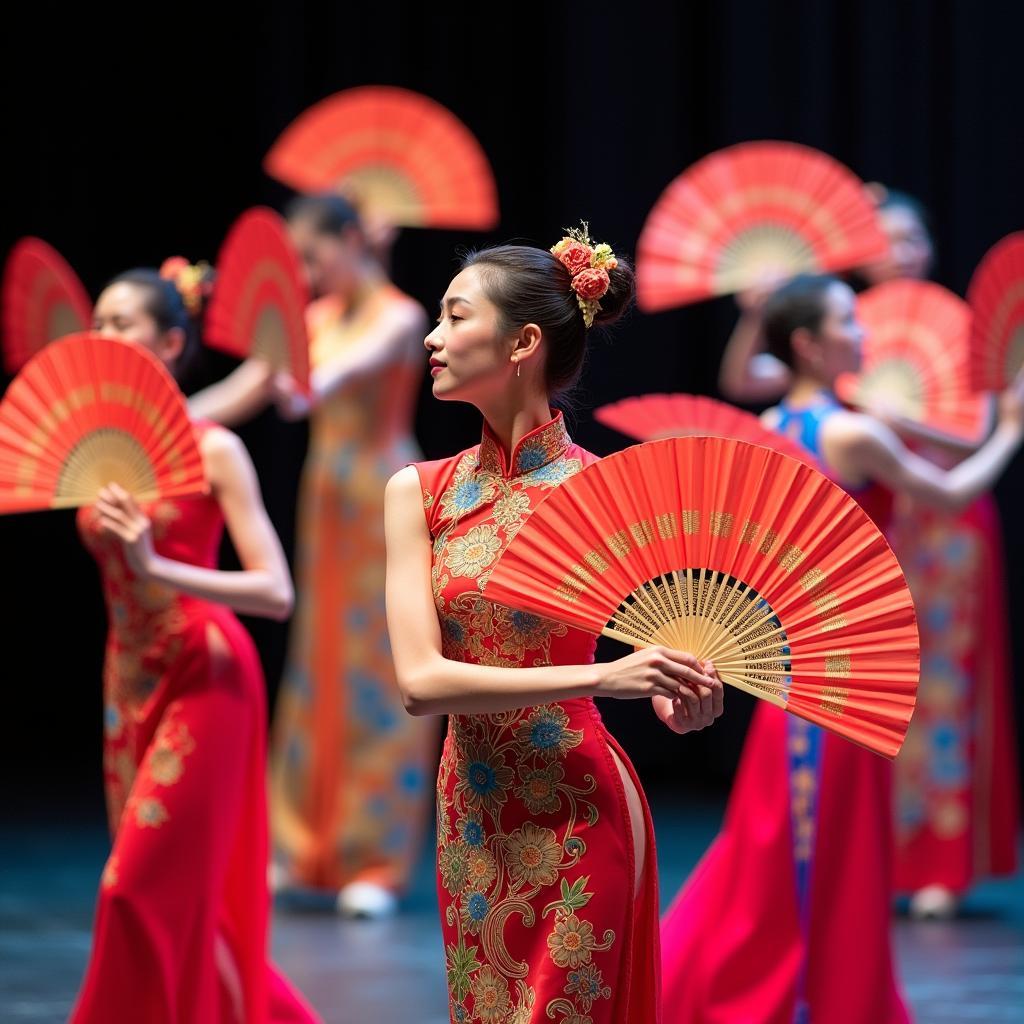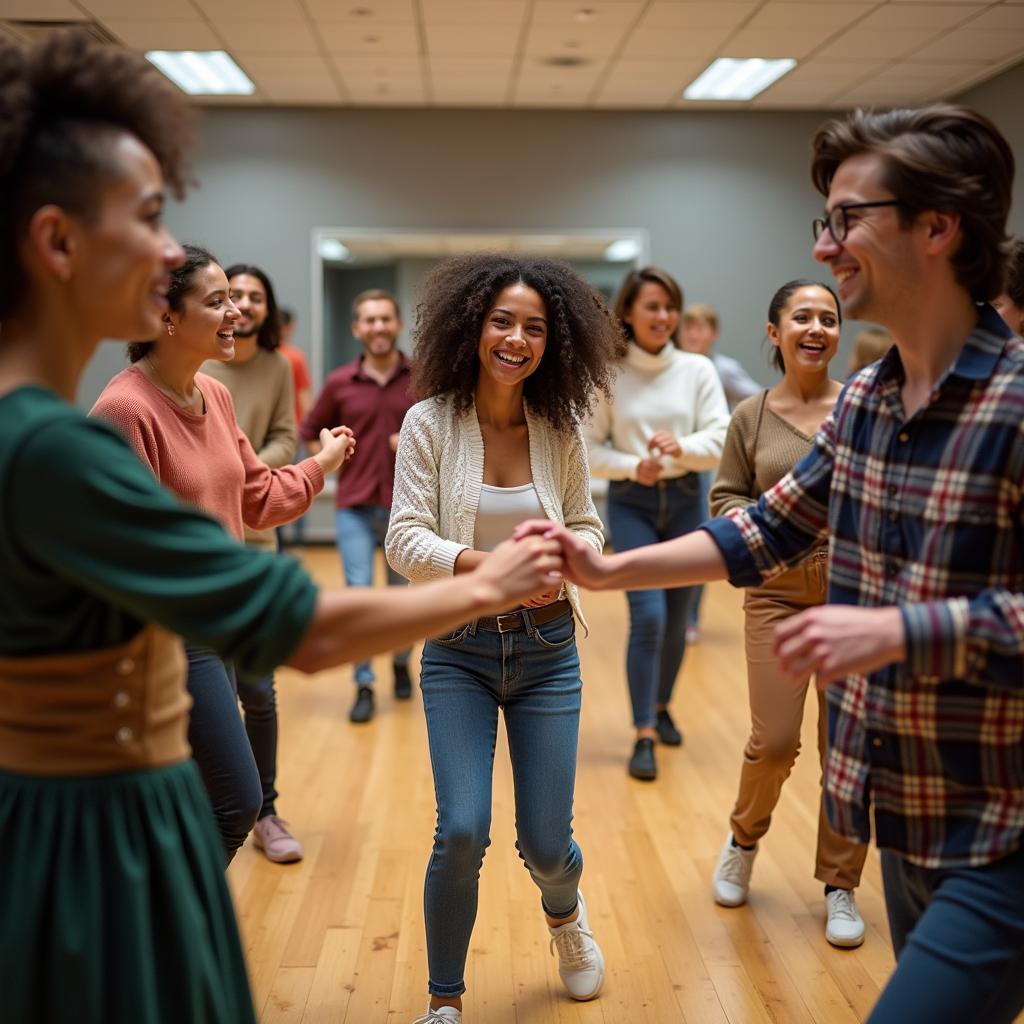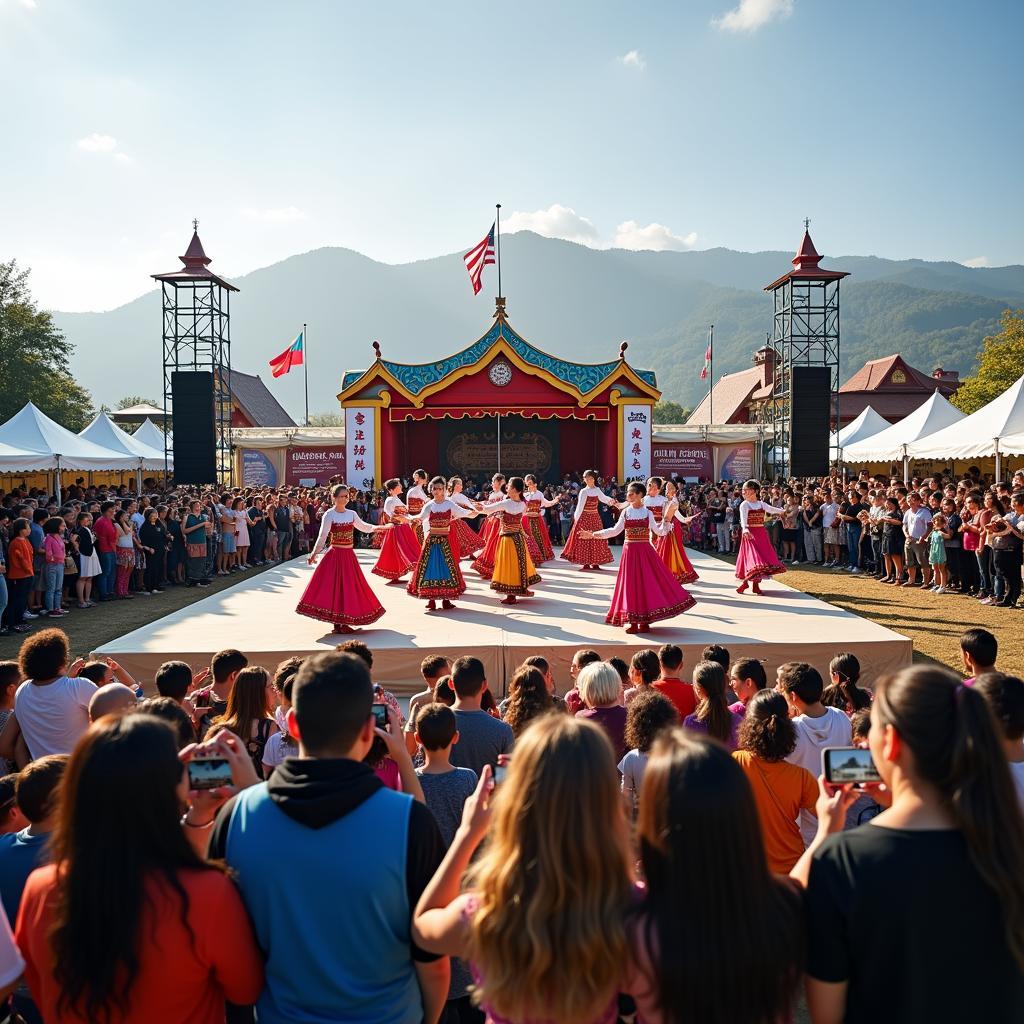Traditional dances are a common topic in IELTS Speaking tests, particularly when discussing cultural heritage and customs. This question type has appeared frequently in past exams and is likely to continue being a popular choice for examiners. Being well-prepared to describe a traditional dance from your culture can significantly boost your confidence and performance in the speaking test.
Describe a cultural activity you participated in can be a great way to practice articulating your thoughts on traditional dances. Let’s explore how to effectively answer questions about traditional dances across different parts of the IELTS Speaking test.
Part 1: Introduction and Interview
In this section, the examiner may ask general questions about dancing and cultural traditions. Here are some possible questions and sample answers:
Sample Question: Do you enjoy dancing?
Band 6-7 Answer:
Yes, I do enjoy dancing. It’s a fun way to express myself and stay active. I particularly like traditional dances from my culture because they have interesting steps and meanings.
Band 8-9 Answer:
Absolutely! I find dancing to be an exhilarating form of self-expression and physical activity. I’m especially drawn to traditional dances from my culture, as they offer a unique blend of artistry and historical significance. The intricate footwork and symbolic gestures never fail to captivate me.
Part 2: Long Turn (Cue Card)
Here’s a sample cue card related to describing a traditional dance:
Describe a traditional dance in your culture
You should say:
- What the dance is called
- When people perform this dance
- What the dance movements are like
- And explain why this dance is important in your culture
Sample Answer (Band 8-9)
I’d like to talk about the traditional Vietnamese fan dance, which is an integral part of our cultural heritage. This elegant dance, known as “Múa Quạt” in Vietnamese, is a captivating performance that showcases the grace and beauty of our traditional arts.
The fan dance is typically performed during special occasions and festivals, such as Lunar New Year celebrations, cultural exhibitions, and even wedding ceremonies. It’s a dance that symbolizes joy, prosperity, and good fortune, making it a popular choice for events that mark new beginnings or important milestones.
The dance movements are characterized by their fluidity and precision. Dancers, usually young women, hold ornate fans made of bamboo and silk. They gracefully manipulate these fans, creating mesmerizing patterns in the air as they twirl and sway. The choreography often mimics the gentle movements of flowers swaying in the breeze or the fluttering of butterflies. The dancers’ steps are light and measured, with elegant arm gestures that complement the fan movements.
 Vietnamese women performing traditional fan dance with ornate fans, showcasing cultural heritage for IELTS preparation.
Vietnamese women performing traditional fan dance with ornate fans, showcasing cultural heritage for IELTS preparation.
This dance holds great importance in Vietnamese culture for several reasons. Firstly, it serves as a living link to our past, preserving traditional aesthetics and values. The fan dance embodies the qualities highly prized in Vietnamese culture – grace, harmony, and subtle beauty. Moreover, it’s a form of artistic expression that allows performers to convey emotions and tell stories without words, relying solely on movement and visual imagery.
Additionally, the fan dance plays a crucial role in cultural education and preservation. By teaching and performing this dance, we ensure that younger generations remain connected to their roots and understand the artistic traditions of their ancestors. It’s not just a dance, but a vessel for cultural knowledge and identity.
Follow-up Questions
- How has this traditional dance evolved over time?
Band 6-7 Answer:
The fan dance has changed a bit over the years. While the basic movements remain the same, modern performances sometimes include new elements like different music or costumes to appeal to younger audiences.
Band 8-9 Answer:
The evolution of the Vietnamese fan dance is a fascinating blend of tradition and innovation. While the core elements and symbolism remain intact, there have been subtle adaptations to suit contemporary tastes and contexts. For instance, some modern interpretations incorporate elements of ballet or contemporary dance, creating a fusion that bridges generations. Additionally, the music accompanying the dance has evolved, sometimes featuring modern instrumentation alongside traditional melodies, which helps to keep the art form relevant and engaging for younger audiences.
- Do you think traditional dances are losing popularity among young people?
Band 6-7 Answer:
It’s true that some young people are less interested in traditional dances nowadays. They often prefer modern dance styles. However, there are still efforts to keep traditional dances alive through cultural programs and schools.
Band 8-9 Answer:
While there’s undoubtedly a shift in young people’s interests towards more contemporary forms of entertainment, I wouldn’t say traditional dances are losing popularity entirely. Rather, we’re seeing a transformation in how these dances are perceived and practiced. Many young people are rediscovering their cultural roots and finding innovative ways to incorporate traditional elements into modern expressions. Moreover, social media and cultural exchange programs have sparked a renewed interest in traditional dances, often presenting them in a fresh, appealing light. The key lies in striking a balance between preserving authenticity and embracing modernity to ensure these cultural treasures remain relevant and appreciated.
 Diverse group of young people enthusiastically learning traditional folk dance steps in a bright studio, showing cultural revival and youth engagement.
Diverse group of young people enthusiastically learning traditional folk dance steps in a bright studio, showing cultural revival and youth engagement.
Part 3: Two-way Discussion
In this section, the examiner will ask more abstract questions related to traditional dances and cultural preservation.
Sample Questions and Answers
- What role do traditional dances play in preserving a country’s culture?
Band 6-7 Answer:
Traditional dances are important for preserving culture because they show the history and values of a country. They help people remember old customs and pass them on to younger generations. These dances also make people feel connected to their roots.
Band 8-9 Answer:
Traditional dances play a pivotal role in cultural preservation, serving as living archives of a nation’s heritage. They encapsulate not just movement, but also embody historical narratives, social norms, and spiritual beliefs that have shaped a society over generations. These dances act as a tangible link to the past, allowing people to physically experience and connect with their ancestors’ traditions. Moreover, they serve as a medium for intergenerational knowledge transfer, ensuring that cultural wisdom and artistic expressions are not lost to time. In an increasingly globalized world, traditional dances also function as cultural ambassadors, promoting understanding and appreciation of diverse heritage among different communities.
- How can governments encourage the preservation of traditional arts like dance?
Band 6-7 Answer:
Governments can help preserve traditional arts by funding cultural programs and including them in school curriculums. They can also organize festivals to showcase these arts and support artists who practice traditional forms. Creating museums or cultural centers is another good way to keep these traditions alive.
Band 8-9 Answer:
Governments can play a crucial role in safeguarding traditional arts through a multi-faceted approach. Firstly, they can implement comprehensive educational policies that integrate traditional arts into school curricula, ensuring young people are exposed to their cultural heritage from an early age. Additionally, establishing dedicated funding streams for traditional art forms can provide much-needed financial support to artists and organizations working to preserve these practices.
Governments can also foster public-private partnerships to create sustainable models for cultural preservation, engaging both state resources and private sector innovation. Organizing high-profile cultural events and festivals can significantly raise the profile of traditional arts, attracting both domestic and international attention. Furthermore, implementing cultural exchange programs can promote cross-cultural understanding and appreciation of traditional arts on a global scale.
Lastly, governments should consider leveraging technology to document and disseminate traditional art forms, creating digital archives and interactive platforms that make these cultural treasures accessible to wider audiences. By adopting such a holistic strategy, governments can effectively champion the cause of cultural preservation while ensuring traditional arts remain relevant and vibrant in contemporary society.
 Large outdoor stage with traditional dancers performing at a government-sponsored cultural festival aimed at arts preservation and community engagement.
Large outdoor stage with traditional dancers performing at a government-sponsored cultural festival aimed at arts preservation and community engagement.
Key Vocabulary and Phrases for High Scores
To elevate your responses and aim for higher band scores, consider incorporating these sophisticated vocabulary items and phrases:
-
Cultural heritage /ˈkʌltʃərəl ˈherɪtɪdʒ/ (noun): The legacy of physical artifacts and intangible attributes of a group or society.
Example: “The fan dance is a vital part of our cultural heritage.” -
Intangible /ɪnˈtændʒəbl/ (adjective): Unable to be touched; not having physical presence.
Example: “Traditional dances represent the intangible aspects of our culture.” -
Choreography /ˌkɒriˈɒɡrəfi/ (noun): The sequence of steps and movements in dance.
Example: “The choreography of the fan dance is both intricate and graceful.” -
Preserve /prɪˈzɜːv/ (verb): Maintain something in its original or existing state.
Example: “It’s crucial to preserve traditional dances for future generations.” -
Embody /ɪmˈbɒdi/ (verb): Be an expression of or give a tangible or visible form to an idea, quality, or feeling.
Example: “This dance embodies the spirit of our ancestors.” -
Revitalize /ˌriːˈvaɪtəlaɪz/ (verb): Imbue with new life and vitality.
Example: “Modern interpretations can help revitalize traditional dance forms.”
Describe a skill you want to master could be an interesting way to talk about learning a traditional dance, connecting it to cultural preservation and personal growth.
Examiner’s Advice
To excel in describing traditional dances in your IELTS Speaking test:
-
Research thoroughly: Familiarize yourself with the history, significance, and details of traditional dances from your culture.
-
Practice describing movements: Use vivid language to paint a picture of the dance in the listener’s mind.
-
Connect to broader themes: Relate the dance to cultural identity, history, and societal values.
-
Use a range of vocabulary: Incorporate dance-specific terms and sophisticated language to demonstrate your linguistic prowess.
-
Provide personal insights: Share your own experiences or feelings about the dance to make your answer more engaging and authentic.
By following these guidelines and incorporating the provided vocabulary and structures, you’ll be well-equipped to deliver a compelling description of a traditional dance in your IELTS Speaking test. Remember, the key is to combine factual information with personal insights and deliver your answer with confidence and fluency.
Describe a season you look forward to every year could be an interesting way to connect traditional dances to specific times of the year when they are typically performed, adding depth to your cultural discussion.


